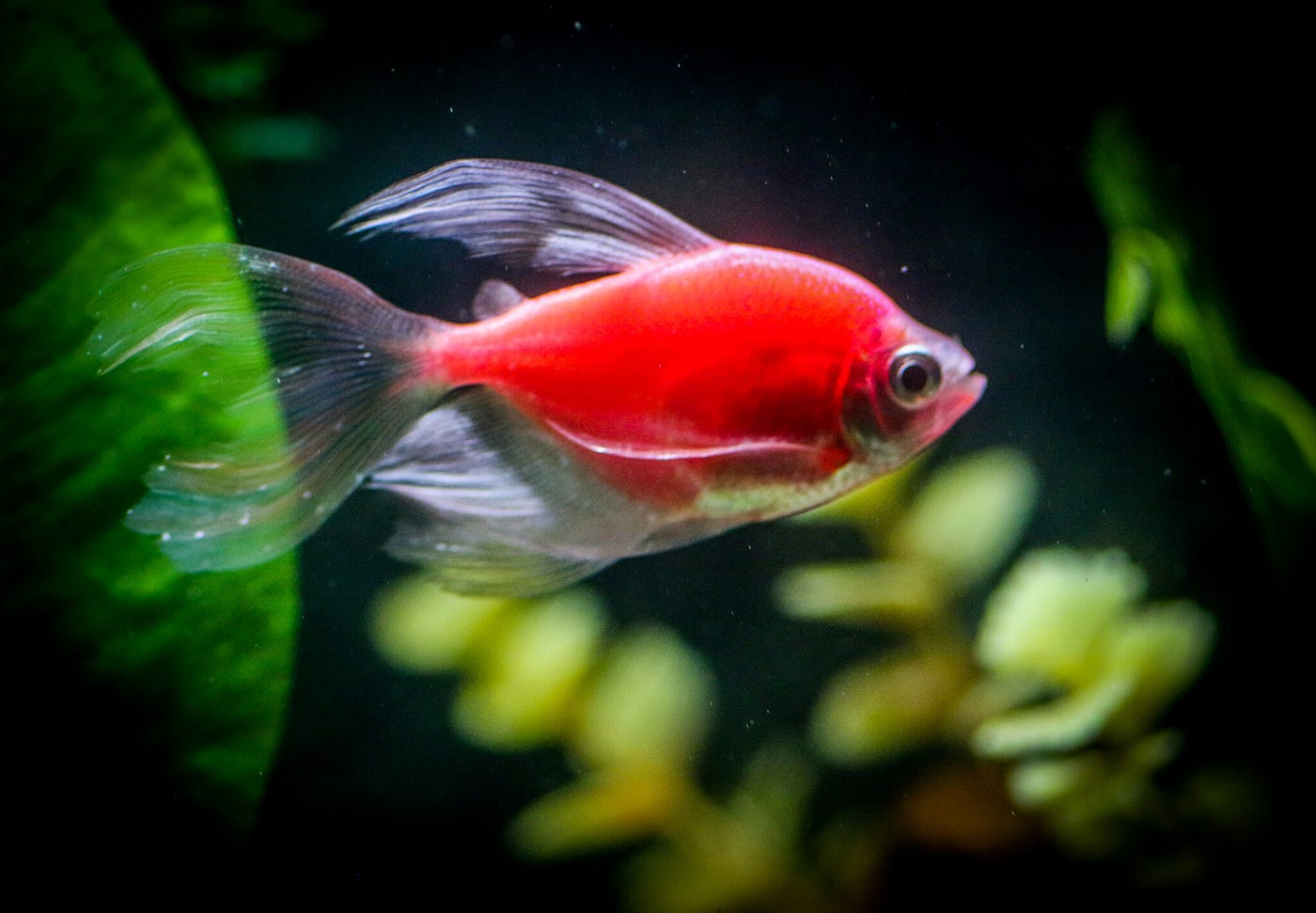GloFish®: How Did this Toxin Detection Experiment Become an Aquarium Pet?
Table of Contents
ToggleGloFish® are the first genetically modified pets. They are fluorescent and sold to countless aquariums worldwide. But did you know that they originated in the National University of Singapore as a way to detect toxins in water? The researchers were trying to create fish that would start glowing in polluted waters when specific proteins switched on.
How Did the Fluorescent Fish Reach Aquarium Shops?
Here is a timeline of GloFish’s invention, patenting, and rise to fame.
1999:
- Dr. Zhiyuan Gong & Co. at the University of Singapore isolated the GFP (Green Fluorescent Protein) gene, first found in a jellyfish. It makes them fluorescent under white and ultraviolet light.
- They added this gene to a Zebrafish embryo, successfully making it fluorescent.
1999–2000:
- After meeting the scientists, Yorktown Technologies L.P. got worldwide rights to trade, sell, or distribute these fish.
- They patented and trademarked it with the name GloFish®.
2003:
- The fish were released into the market after being researched for around 2 years.
These aquarium fish are notably different from the original research purpose, because they glow in all water conditions regardless of pollutants. The company also produced and patented blue, purple, orange, and other color varieties by extracting elements from sea coral.
Are GloFish® Legal?
While Genetically Modified Organisms are nothing new, the GloFish® was a first because most GMOs before this were for the food and agriculture industries. Naturally, it made some people concerned about the possible repercussions. Below are the events that followed.
December 2003:
- FDA declared that the GloFish® are legally allowed to be sold or distributed by the company.
- Why did the Food and Drug Administration have a say in this? It’s because all GMOs before the GloFish were food and fell under the FDA’s jurisdiction, so it extended to the fish as well.
- FDA declared that since these were aquarium fish and not meant to be eaten, the fluorescent protein did not make them any different from normal fish.
January 2004:
- The Center for Food Safety launched a lawsuit against GloFish®.
- They thought that the FDA shouldn’t get a say on this, and that it would lead to an unregulated mess of genetically modified pets.
March 2005:
- The lawsuit was dismissed on account of being without merit. Nearly 18 years later, the predicted explosion of GM pets is yet to happen.
2015:
- California allows GloFish® to be traded and bought in the state after a long ban.
- The ban was made before GloFish was invented, and it affected a genetically modified salmon variety.
It is not yet legal to import GloFish into the European Union because of their stringent regulations over GMOs.
But How Do GloFish® Glow?

- The Green Fluorescent Protein has existed for 160 million years. It was first discovered in a jellyfish named Aequorea victoria.
- These jellyfish had special “photo organs” that glowed green in a camera flash.
- The GFP is a fascinating protein. It is shaped like a soda can and releases green light when it binds with calcium.
- The red version of this protein has two extra chemical bonds in its molecule. It shifts the wavelength of the light to red.
Are All GloFish® One Species?
“GloFish” is a trademarked name for all fluorescent fish marketed by the company, but they can be of several species. Below are some comparisons of the normal fish and its GloFish® variant.
Zebrafish


Tetra


The company also made GloFish Bronzies, Tiger Barbs, Rainbow Sharks, and more.
Are GloFish® Ecologically Safe?
Research has concluded that GloFish aren’t toxic to the environment, and they are not made for consumption. The GFP is their only difference from the regular aquarium species, and they are equally safe for a fish tank.
Recent concerns about them invading freshwater bodies is on the rise, despite previous research about their non-invasive nature. However, the GloFish males tend to be weaker than wild male fish because most people selectively prefer gentle aquarium creatures.
This resulted in something funny. Normal Zebrafish females find the GloFish zebras more attractive that regular males. But the GloFish still have much less success than the wild zebras when it comes to mating! It is because of the wild males’ aggression, which gives them an advantage.
They are also more noticeable by predators because of their bright coloring. It limits their population.
What’s Next?
Scientists have tinkered with glowing varieties of other animals, including nine sheep, a beagle, and the famous cat. However, these are individual experiments, and it is unclear when (or if) they will be as legalized and common as the GloFish®.
